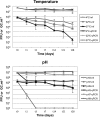Persistence of infectious Shiga toxin-encoding bacteriophages after disinfection treatments
- PMID: 24463973
- PMCID: PMC3993145
- DOI: 10.1128/AEM.04006-13
Persistence of infectious Shiga toxin-encoding bacteriophages after disinfection treatments
Abstract
In Shiga toxin-producing Escherichia coli (STEC), induction of Shiga toxin-encoding bacteriophages (Stx phages) causes the release of free phages that can later be found in the environment. The ability of Stx phages to survive different inactivation conditions determines their prevalence in the environment, the risk of stx transduction, and the generation of new STEC strains. We evaluated the infectivity and genomes of two Stx phages (Φ534 and Φ557) under different conditions. Infectious Stx phages were stable at 4, 22, and 37°C and at pH 7 and 9 after 1 month of storage but were completely inactivated at pH 3. Infective Stx phages decreased moderately when treated with UV (2.2-log10 reduction for an estimated UV dose of 178.2 mJ/cm(2)) or after treatment at 60 and 68°C for 60 min (2.2- and 2.5-log10 reductions, respectively) and were highly inactivated (3 log10) by 10 ppm of chlorine in 1 min. Assays in a mesocosm showed lower inactivation of all microorganisms in winter than in summer. The number of Stx phage genomes did not decrease significantly in most cases, and STEC inactivation was higher than phage inactivation under all conditions. Moreover, Stx phages retained the ability to lysogenize E. coli after some of the treatments.
Figures



Similar articles
-
Shiga toxin-producing Escherichia coli strains from cattle as a source of the Stx2a bacteriophages present in enteroaggregative Escherichia coli O104:H4 strains.Int J Med Microbiol. 2013 Dec;303(8):595-602. doi: 10.1016/j.ijmm.2013.08.001. Epub 2013 Aug 16. Int J Med Microbiol. 2013. PMID: 24012149
-
Implications of free Shiga toxin-converting bacteriophages occurring outside bacteria for the evolution and the detection of Shiga toxin-producing Escherichia coli.Front Cell Infect Microbiol. 2014 Apr 16;4:46. doi: 10.3389/fcimb.2014.00046. eCollection 2014. Front Cell Infect Microbiol. 2014. PMID: 24795866 Free PMC article. Review.
-
Contribution of cropland to the spread of Shiga toxin phages and the emergence of new Shiga toxin-producing strains.Sci Rep. 2017 Aug 10;7(1):7796. doi: 10.1038/s41598-017-08169-6. Sci Rep. 2017. PMID: 28798380 Free PMC article.
-
Multilocus characterization scheme for shiga toxin-encoding bacteriophages.Appl Environ Microbiol. 2007 Dec;73(24):8032-40. doi: 10.1128/AEM.01278-07. Epub 2007 Oct 19. Appl Environ Microbiol. 2007. PMID: 17951439 Free PMC article.
-
Shiga toxins and stx phages: highly diverse entities.Microbiology (Reading). 2015 Mar;161(Pt 3):451-62. doi: 10.1099/mic.0.000003. Epub 2014 Dec 5. Microbiology (Reading). 2015. PMID: 25479836 Review.
Cited by
-
Modulation of Enterohaemorrhagic Escherichia coli Survival and Virulence in the Human Gastrointestinal Tract.Microorganisms. 2018 Nov 19;6(4):115. doi: 10.3390/microorganisms6040115. Microorganisms. 2018. PMID: 30463258 Free PMC article. Review.
-
Don't Shut the Stable Door after the Phage Has Bolted-The Importance of Bacteriophage Inactivation in Food Environments.Viruses. 2019 May 22;11(5):468. doi: 10.3390/v11050468. Viruses. 2019. PMID: 31121941 Free PMC article. Review.
-
Increasing incidence of non-O157 Shiga toxin-producing Escherichia coli (STEC) in Michigan and association with clinical illness.Epidemiol Infect. 2016 May;144(7):1394-405. doi: 10.1017/S0950268815002836. Epub 2015 Nov 20. Epidemiol Infect. 2016. PMID: 26584572 Free PMC article.
-
An Environmental Shiga Toxin-Producing Escherichia coli O145 Clonal Population Exhibits High-Level Phenotypic Variation That Includes Virulence Traits.Appl Environ Microbiol. 2015 Dec 4;82(4):1090-1101. doi: 10.1128/AEM.03172-15. Print 2016 Feb 15. Appl Environ Microbiol. 2015. PMID: 26637597 Free PMC article.
-
In Vitro and In Vivo Assessment of the Potential of Escherichia coli Phages to Treat Infections and Survive Gastric Conditions.Microorganisms. 2021 Sep 3;9(9):1869. doi: 10.3390/microorganisms9091869. Microorganisms. 2021. PMID: 34576765 Free PMC article.
References
-
- Erickson MC, Doyle MP. 2007. Food as a vehicle for transmission of Shiga toxin-producing Escherichia coli. J. Food Prot. 70:2426–2449 - PubMed
Publication types
MeSH terms
Substances
LinkOut - more resources
Full Text Sources
Other Literature Sources
Medical
Molecular Biology Databases

